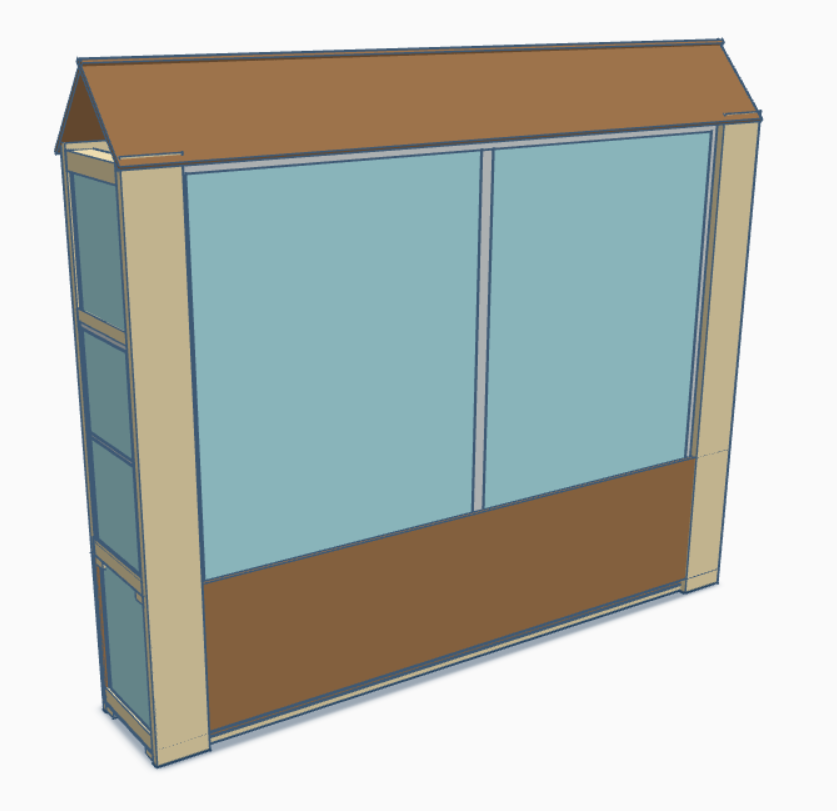PRE2024 3 Group20
Members
| Name | Number | Study |
|---|---|---|
| Neesanth Murugesh | 1777866 | Electrical Engineering |
| Atreya Viswanathan | 1781340 | Electrical Engineering |
| Chenwei Gao | 1789775 | Electrical Engineering |
| Prannoy Kapoor | 1785427 | Electrical Engineering |
| Gaurav Sharma | 1783297 | Electrical Engineering |
Introduction
Problem Statement and Objectives
Home automation systems, including automatic lighting and temperature control have recently become widely adopted in modern smart homes, to save energy and serve as a convenient alternative to manual controls. This promotes sustainability and convenience while also serving the needs of people who are unable to manage their homes independently, such as the elderly or disabled. Though the market for home automation is highly saturated with companies such as Google, Philips and Amazon designing sophisticated, there is a lack of automation systems for greenhouses and gardens. While they exist, our group believes that there is significant potential and a gap in the market for such a series of products, which monitor and automatically control certain parameters in gardens and greenhouses such that plants and crops remain healthy in the absence of human intervention.
A holistic approach that monitors parameters such as temperature, carbon dioxide concentrations, soil moisture, and light, can be used to control a series of actuators that act such that each of the parameters are optimized for the crops grown by the user. To accompany the system, a smartphone app can also be developed such that the user can customize the settings depending on their crops. A more thorough description of the features and functionality of the product is given in subsequent sections of this page. The problem statement or main objective of this project is “to design a series of products that demonstrate the possibility of the automation of greenhouses, promoting sustainability and convenience in agricultural domains”.
Target Audience
The primary target audience for our mini-greenhouse automation system are young adults. This audience is particularly interesting as they are constantly exploring new hobbies and embrace technology enabled solutions. With an ever growing importance of the environment, this target group is more inclined to adopt an automated greenhouse system that helps them connected to nature. Moreover, the system provides a beginner friendly avenue to explore this hobby and learn to grow plants, without investing much time without a big investment.
The project is a scaled-down, aesthetically pleasing greenhouse designed to fit in an apartment, similar to a shelf. This design makes it more accessible to young adults, who live in apartments and have limited budgets. The mini-greenhouse can therefore offer an affordable, low-maintenance solution, making it a great choice for those with busy schedules while still allowing them to grow plants.
A secondary target audience could be schools/educational institutions who could use the mini greenhouse for educational purposes. For examples, the teachers could use two mini-greenhouses as a comparison, one with ideal conditions and the other with altered parameters and demonstrate their impact on plant growth to the students. However, since any greenhouse could serve this purpose, this is considered a natural use case rather than the primary focus of the project.
Requirements of Target Audience
The user requirements of an automated greenhouse system are customizable greenhouses fitted with multiple devices to control the greenhouse environment. Sensors with the ability to measure CO2, humidity, temperature, soil moisture, and soil pH levels are required as an input to the system. Actuators to control the Windows, irrigation systems and heating systems are required to control the environment based on decisions made by the system. The system should set certain parameters such as temperature, soil moisture, humidity, and CO2 levels, based on the plants planted inside the greenhouse. The system then can use predicted weather patterns to further improve the efficiency of the greenhouse.
MoSCoW prioritization method
Must Have –
- Environment Monitoring – CO2, temperature, humidity, soil moisture, and soil pH levels.
- Environment Controlling Systems – Irrigation Systems, Ventilation, and Heating.
- Continuous Monitoring – The system must monitor and control the environment in real time.
Should Have –
- Energy Management – Using electricity and water efficiently.
- Notifications to the User – Notify user if something is malfunctioning.
- Remote Access & Control – The user can monitor and control the greenhouse when on vacation or work.
Could Have –
- Al Monitoring – The AI can use predicted weather forecast to further utilize the energy consumption.
- Plant based monitoring- The user enters the plants inside the greenhouse, the system uses existing research and databases to find the optimum environment conditions.
Will not Have –
- Pesticide Control – controlling pests and disease using AI powered Cameras.
- Water Quality Control – Checking the water for contamination.
- Automated Planting and Harvesting
Approach, milestones and deliverables
| Week | Plan |
|---|---|
| Week 2 | Introduction and Problem Statements
Users and Target Audiences, and User requirements Literature Study and State-of-the-Art |
| Week 3 | User Survey and Survey Results
User Requirements updated based on survey results Initial Planning and finalizing deliverables Task Division by deciding sub-modules |
| Week 4 | Research on Components, Arduino boards, and software to use
Building an Initial prototype Design on a 3D software or make a drawing Ordering Components and the Arduino board Update Wiki-Page |
| Week 5 | Finalizing Components, Arduino boards, and software to use
Finish and send it for 3D printing. Start Arduino Coding Start Website Coding |
| Week 6 | Assembling the Product
Finish Building the website to monitor Each sub-module individual testing Debugging and fixing errors |
| Week 7 | Final Testing with all sub-modules together
Finalizing Wiki Site |
Final Deliverable: Miniature greenhouse automation system for American homeowner gardens. The automaton system will include:
- Environment Monitoring – CO2, temperature, humidity, soil moisture, and soil pH levels.
- Environment Controlling Systems – Irrigation Systems, Ventilation, and Heating.
- Continuous Monitoring – The system must monitor and control the environment in real time.
- Energy Management – Using electricity and water efficiently.
- Notifications to the User – Notify user if something is malfunctioning -> Realized through a website
- Remote Access & Control – The user can monitor and control the greenhouse when on vacation or work -> Realized through a website
This will be realized using Arduino microcontrollers and low-cost electronics to ensure a cheap product for all homeowners.
Weekly Team Role Division
| Name | Total | Break-down |
|---|---|---|
| Neesanth Murugesh | 9h | Attended kick-off (2h), group meeting (2h), research and article summarizing (3h), Requirements of User (2h) |
| Atreya Viswanathan | 9h | Attended kick-off (2h), group meeting (2h), research of existing literature/state-of-the-art (3h), Problem Statement/Objectives (2h) |
| Chenwei Gao | 8h | Attended kick-off (2h), group meeting (2h), research and article summarizing (3h), user research (1h) |
| Prannoy Kapoor | Attended kick-off (2h), group meeting (2h) | |
| Gaurav Sharma | Attended kick-off (2h), group meeting (2h) |
| Name | Total | Break-down |
|---|---|---|
| Neesanth Murugesh | ||
| Atreya Viswanathan | ||
| Chenwei Gao | ||
| Prannoy Kapoor | ||
| Gaurav Sharma |
| Name | Total | Break-down |
|---|---|---|
| Neesanth Murugesh | ||
| Atreya Viswanathan | ||
| Chenwei Gao | ||
| Prannoy Kapoor | ||
| Gaurav Sharma |
| Name | Total | Break-down |
|---|---|---|
| Neesanth Murugesh | ||
| Atreya Viswanathan | ||
| Chenwei Gao | ||
| Prannoy Kapoor | ||
| Gaurav Sharma |
| Name | Total | Break-down |
|---|---|---|
| Neesanth Murugesh | ||
| Atreya Viswanathan | ||
| Chenwei Gao | ||
| Prannoy Kapoor | ||
| Gaurav Sharma |
Greenhouse Implementation
Design
-
Greenhouse Design
Literature Study and State-of-the-art
Gaurav -
An Analysis of Global Research Trends on Greenhouse Technology: Towards a Sustainable Agriculture
The study analyzes global research trends in greenhouse technology over the last two decades, focusing on sustainability and food security. The main key topics discussed in this article main cover the following topics: use of water for irrigation, the design of the greenhouse, conserving the soil conditions, total energy consumption of the system, temperature control and pest control. These are the main factors that make up a good greenhouse.
The Role of Greenhouse Technology in Streamlining Crop Production
This scientific article goes over the advantages of the greenhouse and its impact on crops. It goes over the best materials and design which should be used in the making of a greenhouse, such as glass and polyethylene. It also goes over the key components of automation and control systems such as lighting and irrigation.
· https://d1wqtxts1xzle7.cloudfront.net/38863834/62_IJRG15_S09_101-libre.pdf?1443011423=&response-content-disposition=inline%3B+filename%3DGREENHOUSE_TECHNOLOGY.pdf&Expires=1739664144&Signature=A64huUOgdysHXVmwfAQ3aTZ~2T2D-D-B2P~36bgSdVZuXVUf1edCT8AthR8Mz2ReMxoSVCZM~8ChKGwyMuDbSYriLKkdn7BwhwWuy92X0rjMJHBM6oQAKQFJ60RVTO2ewzV0674Ka7jewQrFa~rZJxNjPgnnfr77cd9-322FsN21K9qlRkHeWlwg6iajeaT2tGjsXnif2YcT0lFFPo79GBWA4paMFaFVlh9x1nBEU-PFVl3tELHbLXLVLHtG1rZLCG8O2IMQFhrKVuV9mSxcTy3qCTVnhBmEETYnTnTVRMBT126CdR5giACUhmzQHNkO~5OcEsoKP5WBE83GyWKeVw__&Key-Pair-Id=APKAJLOHF5GGSLRBV4ZA
This article goes over the main advantages of a greenhouse, such as increased production and disease-free plants. It also lists greenhouse types and shapes which are most commonly used.
A Critical Review of the Status of Current Greenhouse Technology in China and Development Prospects
This article explains the status of greenhouse technology in China. It goes over the development of the green houses from the first few models made from simple materials like bamboo to better materials such as steel with automated equipment. It also goes over the main problems which come with the greenhouses, such as too much water usage and irrigation failures.
Design, technology, and management of greenhouse: A review
This review explores advancements in greenhouse technology for optimizing plant growth by controlling temperature, humidity, light, and CO2. It covers the many factors of greenhouse design such as climate control technologies, management systems, emphasizing automation, and energy efficiency. Key factors such as ventilation for humidity control and optimal temperature ranges for crops are also mentioned as well. The study highlights strategies to enhance yield while reducing costs and energy consumption.
Prannoy -
Portable greenhouse structure and method and apparatus for assembling same
The present invention provides a portable greenhouse structure comprising a base in the shape of a right-polygonal cylinder having a top and a bottom, wherein the base comprises a plurality of wall panels connected along abutting edges.
Introduces a climate control by also enabling a method of portable, structurally efficient, and easy to assemble and disassemble. This way a green house can be inexpensive and need not be permanent in nature. This way people can explore hobbies before completely committing.
Mini-greenhouse and plant protector
A one piece, nestable, portable mini-greenhouse and plant protector for use in a substrate, such as soil, to protect plants and seedlings from extreme weather elements, bugs and pests. The mini-greenhouse has a light-transmitting shell that forms a protective chamber and integrated legs that act to anchor as well as support the shell. The unit has concave channels that facilitate watering without disturbing the apparatus. It has unique light filtering and dispersing properties to aid creating a nurturing and growing environment.
Vertically integrated greenhouse
A vertically-integrated greenhouse for growing plants in suspended trays. The design is particularly well-suited for installation in a double-skin façade of a building, or in an interior atrium, lobby, or similar structure. Introduces a system that uses a network of sensors to monitor key variables such as temperature, humidity, and soil moisture. This data is then used to control actuators connected to heating, cooling, ventilation, and irrigation systems, ensuring optimal conditions for plant growth. The system reduces energy waste by making real-time adjustments only when necessary by a tray-spacing mechanism, ultimately improving crop yield while conserving, thereby maximizing crop yield and building energy savings, or for esthetic considerations.
With respect to the scope of the project, mini prototype of a green house for hobbyist is being developed, which are small-scale structures designed for casual gardeners to cultivate various plants, including orchids, bromeliads, bonsai, and even engage in hydroponics. Typically measuring less than 10 feet by 10 feet. The source is a company catering to US consumers who want to grow plants/flowers year round, which it made possible by their Solar Innovations which provides customization to create optimal environments tailored to specific plant cultivation needs
The article "Smart and Efficient Greenhouses: A Systematic Literature Review in the Agronomic, Computational, and Energy Scope" presents a comprehensive analysis of controlled environment agriculture, focusing on the integration of intelligent computational techniques and energy efficiency in greenhouse cultivation.
the researchers identified over 2,000 scientific publications within a 5 to 10-year timeframe and arrowed the publications down to just 66.
The application of automation and control techniques in greenhouses began in the 50s, where temperature control was performed by thermostats. Subsequently, there was a great advance from the structural design to the technological aspects that make up the system, seeking improvement to allow the control of the parameters of temperature and relative humidity, solar radiation, CO2 concentration, ventilation, and fertigation.
Furthermore, results relevant to the project are
- The correct use of land and the efficient use of water and electrical resources stand out. The authors emphasize the need for mechanisms that optimize these environments. However, the use of control systems for these spaces and environments is relatively complex, due to the multiple variables involved and the interdependence between them.
- several control strategies for greenhouses. These strategies aim to make the environment ideal for crops, considering energy savings. Among them, we can mention: mathematical modeling; experimental studies and simulations; control of parameters and components; the use of algorithms and computational intelligence techniques
- The authors highlight that the cost of electricity is the second highest cost in cultivation in controlled environments, with the labor costs being the most expensive.
- aiming to find optimal conditions for the growth and development of seedlings in a greenhouse environment. The authors conclude that the application of IoT associated with product traceability promotes
Atreya -
Greenhouse automation system | Automated greenhouses | Priva
A company called Priva has recently developed a large-scale automation system which enables irrigation, lighting, climate control and even nutrients. These are all essential aspects of crop health and growth, and can be controlled using a smartphone app. While their target audience seems to be larger agricultural businesses, the concepts and ideas are relatively similar to our own project. The main goal is to automate the process such that energy can be saved, mistakes are made less often and to promote convenience for end users. The company seems to be targeting large businesses that specialize in farming and agriculture, and therefore the requirements are bound to be different. In our project, we will take inspiration from such existing state-of-the-art systems and build upon it to ensure user-friendliness, convenience for consumers (especially individual gardeners and greenhouse owners) and sustainability.
Greenhouse Automation - DutchGreenhouses
A competing brand named DutchGreenhouses has also developed a similar greenhouse automation system. Their main selling point is an advanced climate computer, software and sensors which ensure that temperature, moisture, etc., are all optimal for the crops. According to the company, this ensures peak efficiency of the growth as well as peak crop yield.
Greenhouse Automation - Logiqs B.V.
The brand Logiqs B.V. has a very innovative approach to greenhouse automation. It consists of “rolling benches” that move around the greenhouse upon which crops are grown. The company claims that this state-of-the-art technique is highly effective and efficient because physically moving plants across climate zones is far more energy-efficient compared to actively changing the temperature. They also believe that this creates better working conditions and ensures cleanliness due to automated cleaning procedures. The benches are also fitted with automatic irrigation with precise control over the frequency and amount of water and nutrients to be fed to the crops.
A Review of Greenhouse Climate Control and Automation Systems in Tropical Regions
This paper by Shamshiri et al explores greenhouse climate control and its effectiveness. The authors also research the ideal levels of temperature and relative humidity to maintain healthy crops. For example, there is a table providing the ideal temperature and humidity conditions during each growth stage for tomato crops. This information is valuable for designers of greenhouse automation systems as they can design the systems to maintain by default the ideal parameters for optimal crop growth. Users can also refer to this information and customize their systems to ensure peak yield of their crops.
Neesanth –
Automation of Hydroponics Green House Farming using IOT
This article explores the integration of Internet of Things (IoT) technology in hydroponic greenhouse farming to enhance efficiency, productivity, and sustainability. Hydroponics is a soilless farming technique that relies on nutrient-rich water to grow plants, making it highly suitable for controlled environments like greenhouses. The system uses sensors and actuators to monitors and controls essential parameters such as Temperature & Humidity, pH & Electrical Conductivity (EC) of Water, Light Intensity & CO₂ Levels, Water Level & Flow. The IoT-based system allows real-time data collection through sensors, which is then processed and analyzed via a cloud-based platform or mobile application. Automation is achieved through actuators that control irrigation, lighting, ventilation, and nutrient dosing without manual intervention. The observed advantages of the approach include Increased Crop Yield, Water & Resource Efficiency, Remote Monitoring & Control, and Reduction in Labor Costs. Overall, IoT-based automation in hydroponic greenhouses offers a smart, sustainable, and scalable solution for modern agriculture, addressing challenges related to climate change, water scarcity, and food security.
Robotic applications in the automation of agricultural production under greenhouse: A reviewThis review paper examines the role of robotics and automation in modern greenhouse farming, focusing on their applications, benefits, and challenges. The paper focuses on plant monitoring & sensing, autonomous planting & transplanting, irrigation & nutrient delivery, pest & disease detection, harvesting & picking robots, pollination robots. The benefits include higher efficiency & yield, lower labor cost, sustainability and continuous protection. The challenges include high investment costs, careful handling of the plant by robots, and integrating AI and Machine Learning in a dynamic environment.
Parallel Control of Greenhouse Climate With a Transferable Prediction Model
This article explores an AI-driven parallel control approach for optimizing greenhouse climate management, using a transferable prediction model. The goal is to enhance energy efficiency, crop growth, and resource utilization by dynamically adjusting environmental parameters. The Main focus of this article is using parallel control strategies controlling parameters such as CO2, temperature, etc. It also focuses on energy optimization, data driven decision making using prediction model. This results produces benefits such as improved climate control, reduce energy costs, and faster adaptation. Future research could focus on enhancing model accuracy, integrating additional climate factors, and improving generalization across diverse greenhouse settings.
On-line modeling of air temperature system in a naturally ventilated greenhouse
This article presents a real-time (on-line) modeling approach for predicting and controlling air temperature in a naturally ventilated greenhouse. Since temperature regulation is crucial for optimal plant growth, the study focuses on developing a dynamic, adaptive model that responds to changing environmental conditions. This article focuses on real time temperature modelling, Influence of natural ventilation, and energy efficiency. The results produced benefits such as better ventilation managements, accurate temperature prediction and low energy costs. Future work could focus on integrating IoT, AI-based predictions, and multi-factor climate models to further enhance system performance.
Smart Greenhouse Automation and Monitoring System
This article discusses the design and implementation of a smart greenhouse automation system that leverages IoT (Internet of Things) technology for real-time monitoring and control of greenhouse conditions. The system aims to improve crop productivity, resource efficiency, and ease of management by automating key agricultural processes. The article focuses on environmental monitoring, automated climate control, remote access, alerts and notifications, and data logging. The results produced benefits such as higher crop yield, water and energy efficiency, reduced labor costs, and remote accessibility.
Chenwei -
Greenhouse Management and Technology
This is a greenhouse management software developed by a group called “climate control systems”. In the description of the software, they give valuable information regarding what the top 100 North American greenhouse growers are investing in. The number one issue which needs to be addressed and solved is the efficiency of the greenhouse itself. Their software then focuses on monitoring the overall statistics of the greenhouse and seeks to adjust variables like temperatures using a lower energy cost with their software.
This scientific article discusses the main problem of resource management regarding greenhouses, as they often contribute to 10-29% of the greenhouse gas emissions around the world. It also discusses the different control systems which are used in greenhouses, which consists of PIDs, fuzzy logic, and artificial neural networks. Sensors which measure different variables such as temperature, humidity, and CO2 are also mentioned as these variables are often the ones in need of control during the automation process.
aPLANT: A Low-Cost Greenhouse Manager System
This report is about a low-cost greenhouse manager system called “aPLANT”. It discusses the main components of the system and the process for how it works. Soil and temperature/humidity sensors are used in the plant to extract the necessary data, which is sent to an ESP8266, which is a low-cost microcontroller. This microcontroller is linked to a raspberry pi which acts as a main database for the whole project. This allows the important variables such as temperature to be measured.
Greenhouse Intelligent Monitoring and Control Solution
This article discusses the main challenges which are present in greenhouse control and intelligent monitoring. Some challenges presented are the controlling of microclimates for delicate crops such as orchids and exotic types of fruits. These plants require precision farming, which means that the exact variables such as temperature must be met. It also briefly discusses the modern greenhouse environment controls systems, and the controllers used. Lastly, it advocates for the use of an IoT intelligent monitoring system which uses climate, irrigation and other factors in order to properly control the environment to suit plants.
Smart Greenhouse Solutions: IoT-Based Environmental Monitoring and Control
This article discusses the advantages to using a IoT based approach to monitor and control smart greenhouses. It talks about the main components of a greenhouse environment, which includes the following: Lighting, air quality, ventilation, heat, and humidity. Many advantages to using a smart green automation are also discussed, some examples include improve irrigation and fertilization. It also lists the sensors which can be needed to improve the overall quality of the greenhouse. They include CO2 sensors, soil moisture sensors, temperature sensors, water sensors, light sensors, and humidity sensors. These controllers combined with a programmable controller can be extremely efficient in making a proper greenhouse automation system.
User Survey
For experienced gardeners and greenhouse owners:
- How do you currently monitor and manage your greenhouse?
a. Right now, I’m doing everything by myself. My family likes to grow vegetables in our greenhouse for our own cooking and to sell to our community. I have noticed that vegetarianism is becoming very common, and with that the demand for diverse produce has grown tremendously. Together with my family, I monitor and water the plants, maintain the temperature and ensure cleanliness.
b. I have a greenhouse in my backyard, but it's too much of a hassle to constantly manage it properly with daily maintenance checks. I used to grow plants for the winter there.
c. I own a relatively small greenhouse, which only houses a few plants and vegetables. I do all the monitoring and management by myself.
2. What do you like about gardening and managing a greenhouse?
a. It is a family passion. I also enjoy cooking with fresh produce knowing that it comes from my very own garden. It keeps us very healthy and connects us with nature and the environment. I also feel that we have developed a very sustainable and eco-friendly lifestyle. When we have extra vegetables, I also like to sell to our neighbors, and they seem to very much appreciate this initiative.
b. I usually plant foreign vegetables which are hard to get here in my garden, so it’s very rewarding watching them grow and then cooking them when they become ready to harvest.
c. I think gardening is a great way to pass time. Since I’m retired, I usually work in my garden at least 5 times a week. It's a very relaxing activity to do outside. Managing the greenhouse is very nice as well.
3) For your region (US), what are some of the techniques or methods you use to best protect your crops?
a. When the weather is particularly warm, I sometimes use shade cloths or thermal screens in order to protect my crops from excessive heat. Other than that, I use disinfecting tools to prevent any disease spread.
b. I don’t use much to protect my crops from insects, but I do my best to keep them healthy to avoid diseases which sometimes can occur on the vegetables or plants in the garden.
c. I use a mesh around my flowers, and sometimes I bring my plants indoors when it gets too hot in the summers.
4) What are your main struggles with your greenhouse?
a. There are very high heating/cooling costs depending on the weather – energy efficiency is very difficult. Preventing pests is also very difficult because they are often challenging to detect early. When I am busy with my day job, I often cannot ensure that the crops are getting the right amount of water and nutrients.
b. Humidity levels are the biggest problem. Most of the time it rises at nighttime and is very dry during the day.
c. During the winter the energy costs due to heating are the biggest problem. Cold nights require enough heat regularly in order to prevent the plants from being affected.
5) What would you like to automate in your greenhouse, and what are your requirements for such a system?
a. A watering system would be very helpful, in case I forget to water my plants. It doesn’t happen often but on the off chance I do forget, the plants won’t be as affected. A humidity regulator is probably the best as long as it keeps the right amount at all times throughout the day.
b. I would like some kind of automatic watering or irrigation system and temperature regulation. However, I would also need to ensure quality control; maybe some way to monitor myself how the automated system is managing the crops. This would save me time while ensuring quality control.
c. Maybe a temperature regulator, so I don’t have to constantly manage the temperature myself by closing the windows and such.
6) What are some aspects of your greenhouse you believe are best monitored or managed manually (without automation)?
a. In terms of pest control, I believe that humans are better at detecting them for now than automated systems. Humans can also treat specific areas of the greenhouse more easily for pests compared to automated systems that are set to monitor the entire greenhouse. I would also perform inspections of the irrigation lines and greenhouse structure to ensure safety of the crops.
b. Pest control, doing inspections yourself are the best way of detecting them before they become a problem. Also with diseases.
c. Watering during weather changes. Sometimes plants need more or less water depending on the current environment and weather. In those cases, manually watering them would be the best choice.
For younger adults without experience in greenhouse management:
1) Would you consider yourself to be an environmental enthusiast?
a) I wouldn’t call myself an enthusiast, but I do enjoy the environment
b) I care about the environment and try to make sustainable choices, but I wouldn’t call myself an expert.
c) I am an enthusiast, I am studying biomedical sciences at Maastricht, and grew up in the US, where we directly see the effects of the climate crisis on the daily basis.
2) Would you like to have any automation to grow plants in your area, or do you prefer managing everything on your own?
a) I would like some automation to get me through the initial problems
b) I would love some automation to make growing plants easier! I think it would be helpful, especially since I don’t have much experience. But I’d still like to have some control over the process.
c) Considering how busy I am, I would, it would be convenient for me, allowing me to spend my time more efficiently.
3) What type of automation/monitoring would you need to start growing plants?
a) Yeah, I would like automation systems such as talking care of watering the plants, maybe insects
b) I’d need automation for watering and soil conditions. A simple app that tells me when to take action or adjusts settings automatically would be ideal.
c) Watering most likely, as I (regrettably) have forgotten to do so in the past. This would be the most important part for me.
4) How much empty space do you have in your garden?
a) I have lived with my parents and I have plenty of space in my garden for plants.
b) I live in an apartment and have a balcony with maybe a few square meters, placing a full green house will not be possible. A small setup like vertical gardening against one of the walls would work best that wouldn’t require any drilling as it is an rented apartment.
c) I reside in an apartment, which roommates, so I only have my own room to myself (very limited), so you could say that is my “garden space”
5) How much time are you willing to spend on developing this hobby?
a) I do have some time during the weekends, where I usually spend time with my family, so any type of gardening could be a good combined activity.
b) I’d be willing to spend a few hours per week, my work keeps me busy so I wouldn’t want it to feel like a chore. If it’s too time-consuming, I might lose interest.
c) Not too many (2-3 hours), as I am studying my bachelors, but it is something that I would like to explore more thoroughly in the future, such a product would make it easier for me to get into this hobby already.
Components Choices
The automation of the greenhouse is achieved using simple sensors and actuators. The sensors are used to monitor the levels of certain parameters, the microcontroller processes these levels and commands the actuators to act accordingly. With these three steps, the system is made into a coherent and self-sustaining process that requires minimal human intervention. The microcontroller used is:
Arduino Nano 33 IoT: https://www.tinytronics.nl/en/development-boards/microcontroller-boards/arduino-compatible/arduino-nano-33-iot-1 (image below).
This microcontroller is ideal for the project for many reasons. Firstly, its small size allows it to fit easily within the confines of the prototype greenhouse, without being visible such that the design look minimalistic and appealing. It has many analogue input/output pins which are required for the reading of values such as the soil moisture, temperature and CO2. An analogue output pin is also required for the servo motor in order to rotate its shaft to a particular angle (for opening and closing windows of the greenhouse). Furthermore, the digital pins are necessary for actuators such as the relay block which is essentially a voltage-controlled switch used for the water pump. Finally, the microcontroller board comes built in with an Internet of Things and Bluetooth chip which allows for information to be received and sent to/from the user website, where users can remotely monitor and control the system. Given these specifications and requirements, this microcontroller proved to be the ideal choice to manage the automated greenhouse system.
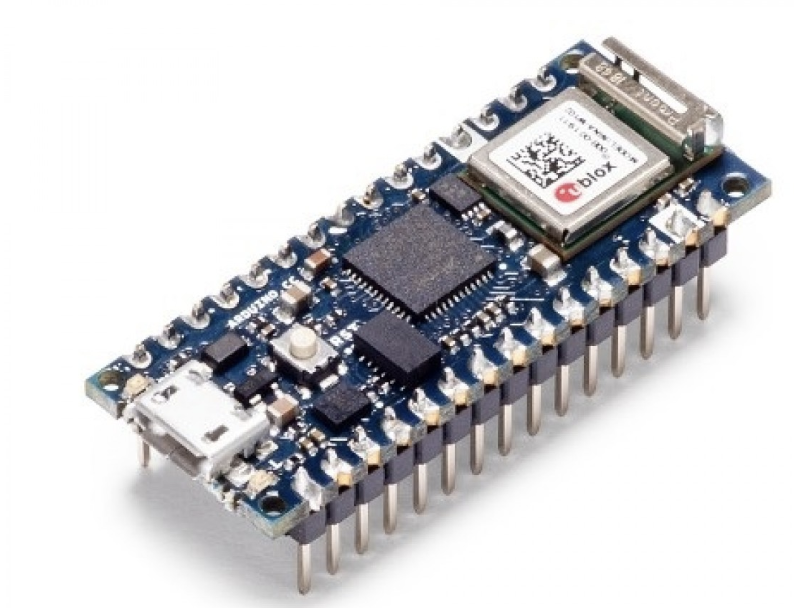
Sensors:
- CO2 Sensor: GY-SCD40 Module - CO2 - Humidity - Temperature Sensor - I2C https://www.tinytronics.nl/en/sensors/air/humidity/gy-scd40-module-co2-humidity-temperature-sensor-i2c. Available in TinyTronics for Euro 19.00. This is a great sensor for our project because it integrates several sensors on one package. This include a CO2 sensor, a humidity sensor as well as a temperature sensor. Therefore, it can supply all these parameters to the microcontroller in intervals. These parameters can be used to control the opening/closing of windows, the heating/ventilation and more. The sensor is also compatible with the Arduino microcontroller platform through the I2C hardware interface, allowing it to be easily integrated with the other sensors/actuators in the automated greenhouse system. For CO2, the sensor can sense between a range of 0 to 40,000 parts per mille (ppm) with a measurement uncertainty of +/-50 ppm (or 5%), which is definitely sufficient for this project. Below is a labelled image of the sensor:
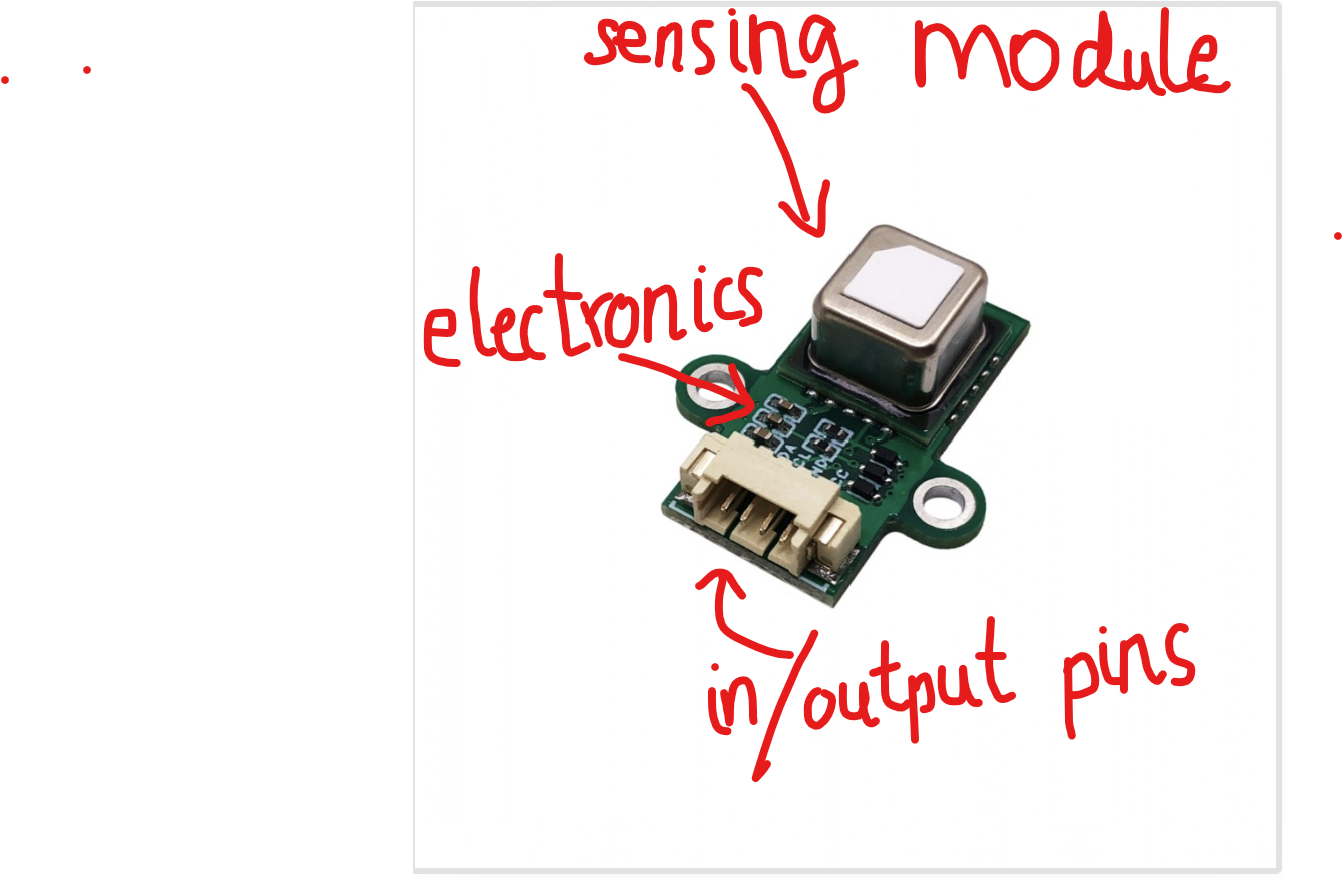
Labelled image of CO2 sensor available at TinyTronics (EUR 19.00) - Soil moisture sensor: Capacitive Soil Moisture Sensor with Cable https://www.tinytronics.nl/en/sensors/liquid/capacitive-soil-moisture-sensor-module-with-cable. The sensor measures the humidity of moisture present in the soil and provides an output in the form of a voltage between 0 and 3.0 V, which correspond to measurements of 0% to 100%. Thus, the output voltage reading can easily be mapped into a soil moisture percentage using the Arduino microcontroller. This information will be used by the microcontroller to actuate the water pump if the soil moisture is too low. Below is an image of the sensor:
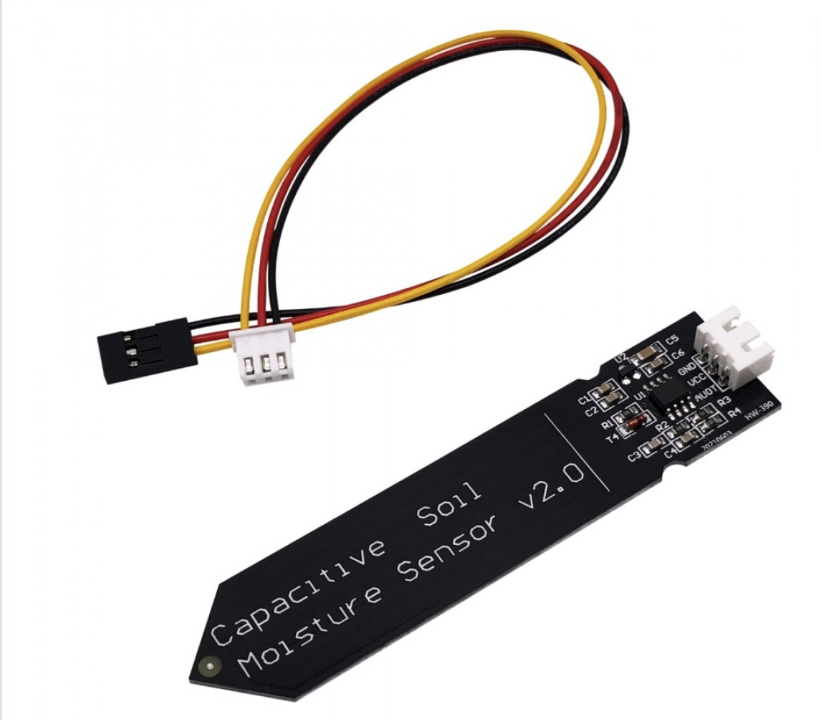
Actuators:
- Servomotor: MG90S Mini Servo https://www.tinytronics.nl/en/mechanics-and-actuators/motors/servomotors/mg90s-mini-servo. This is available from TinyTronics for 5 Euros. The reason for choosing a smaller servo motor compared to a larger one was due to the current requirement. Since this project involves the use of Arduinos, their current output is not enough to handle the larger currents drawn from the the bigger servo motors. The metal gears provide better speed and power compared to other mini servo motors on the market. The main use of this servo motor is to be able to control the ventilation within the greenhouse by opening and closing a window near the top. This helps ventilate the greenhouse in cases where the CO2 levels become too high/low.
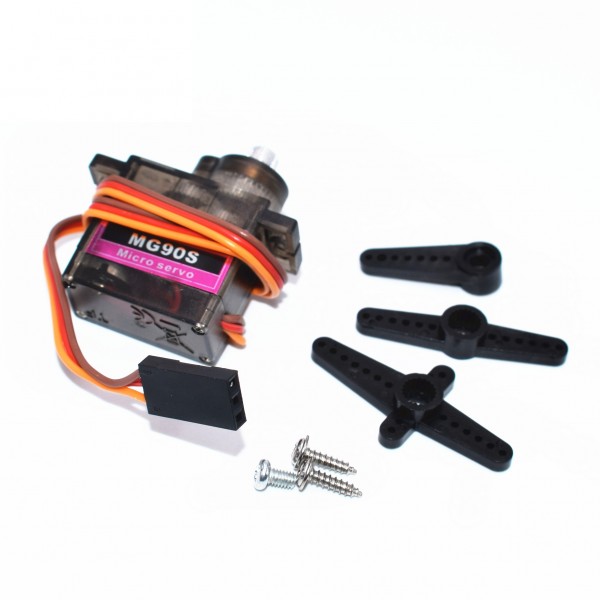
MG90S Mini Servo - Water Pump: Under Water Pump - Horizontal - 3-6V https://www.tinytronics.nl/en/mechanics-and-actuators/motors/pumps/under-water-pump-horizontal-3-6v. This is available from TinyTronics for EUR 4.00. This is a relatively low-powered pump but is more than sufficient for the 'drip' irrigation that our small-scale greenhouse requires. We found that the pump only activates when a DC voltage of at least 5V is supplied to its input pin. As the Arduino microcontroller can provide a maximum of only 3.3V, an additional relay switch, i.e., a voltage-controlled switch which can supply 5V, is also required to use the pump. An image of the water pump is given below:
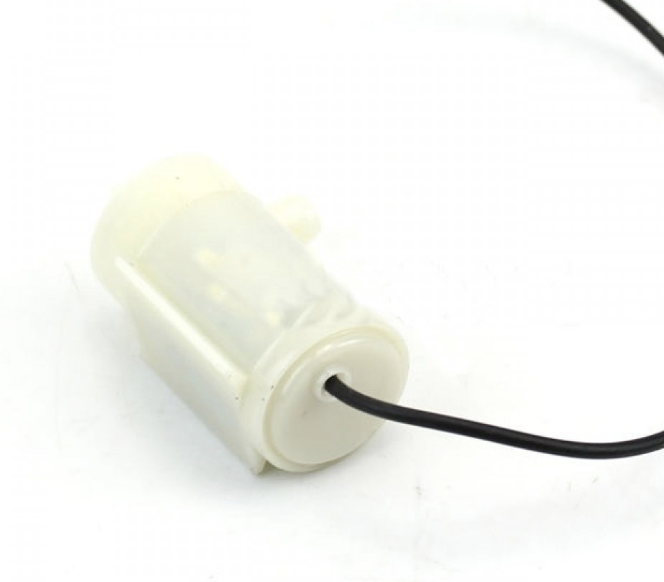
- Relay switch for water pump: 5V relay 1-channel high-active https://www.tinytronics.nl/en/switches/relays/relay-modules/5v-relay-1-channel-high-active. This relay switch is available at TinyTronics for EUR 2.50. As mentioned previously, it is required for effective control of the water pump for the autonomous irrigation system. The relay switch requires a power source of 5V, which will be achieved through a 5V DC adapter connected to a wall outlet. The input "In" pin of the relay will be connected to the a digital pin on the Arduino, which is the control signal instructing the relay to switch on or off. When the Arduino supplies a "high" 3.3 V digital signal to its input pin, the relay switches on and provides 5 V to the water pump through its output pins (on left of the image below).
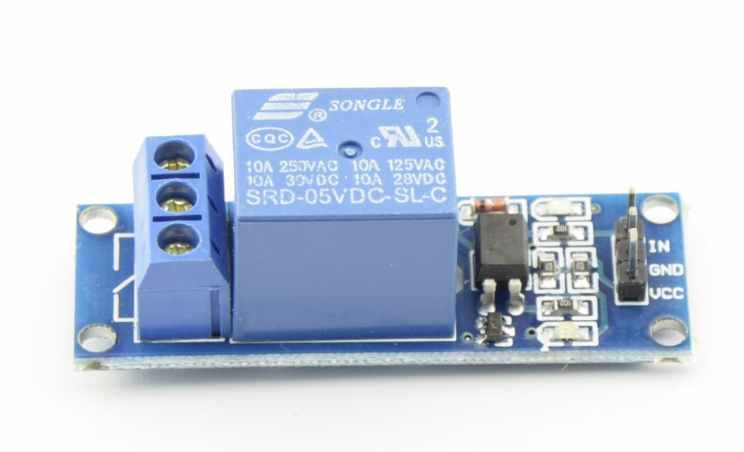
System Level Design
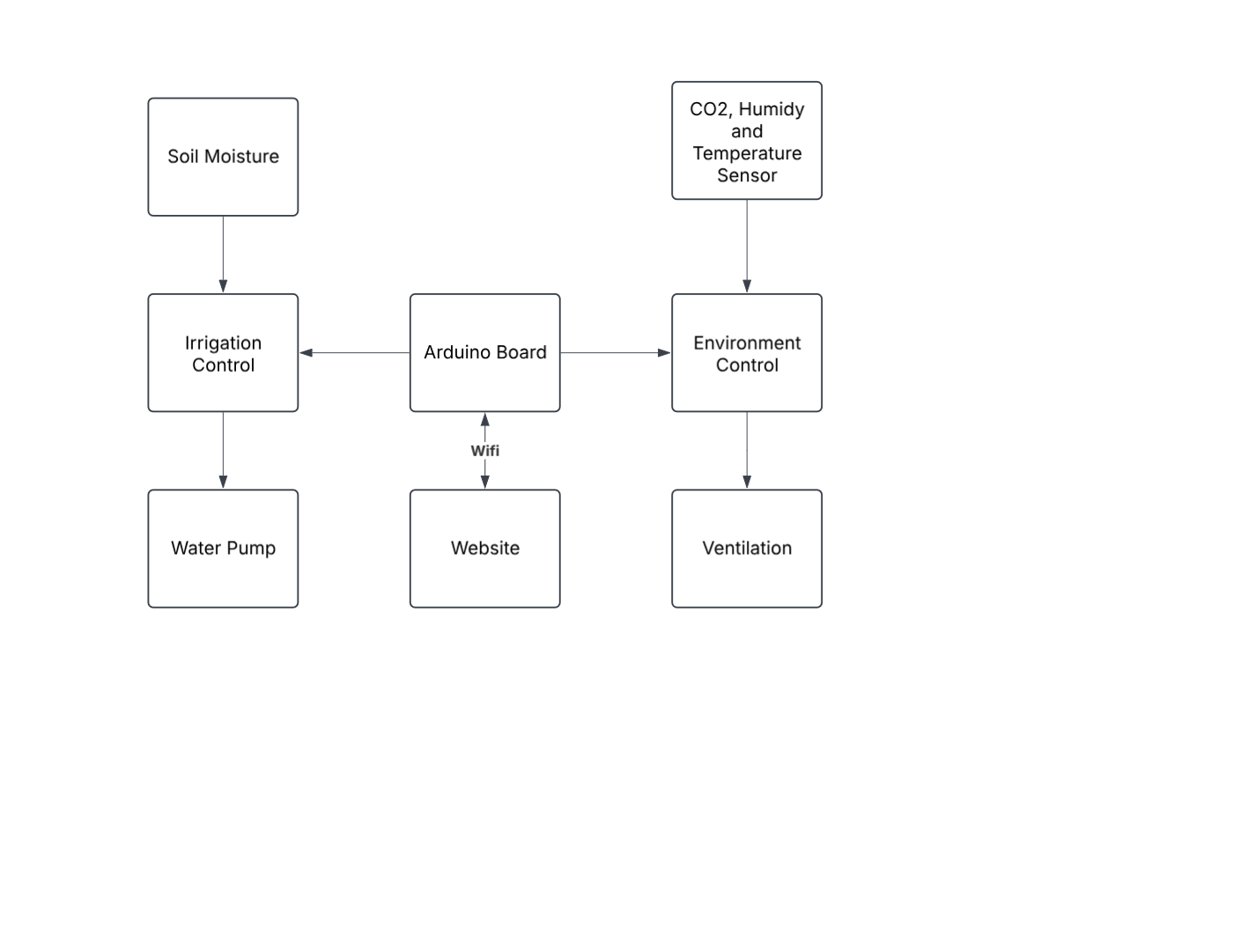
Brainstorming, Initial Designs and Final Prototype
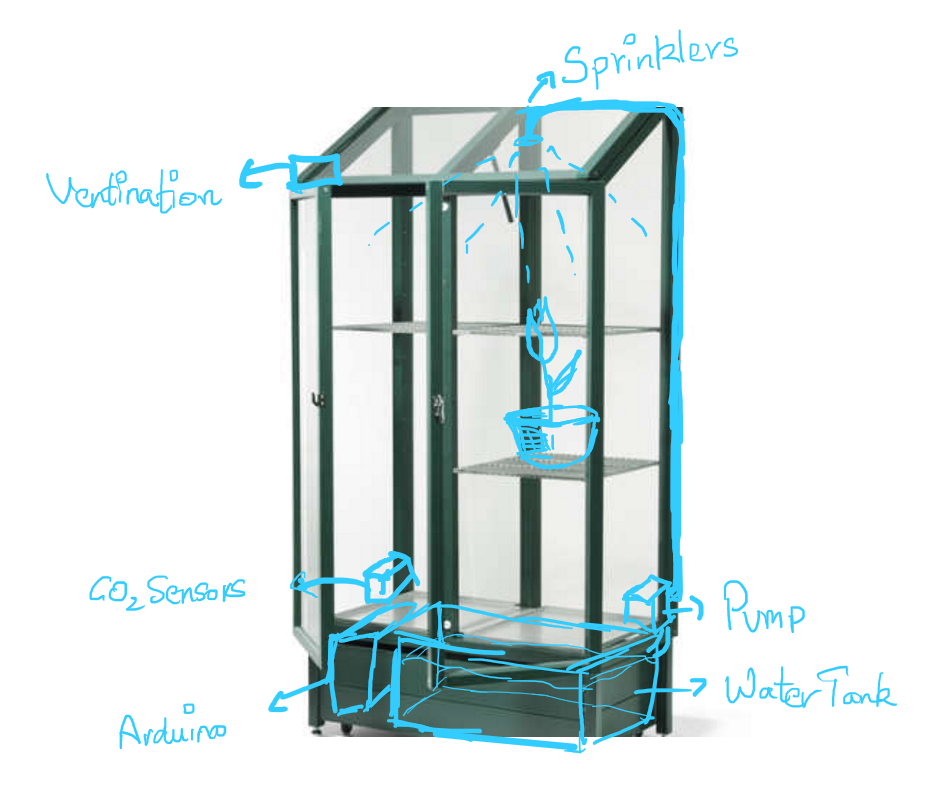
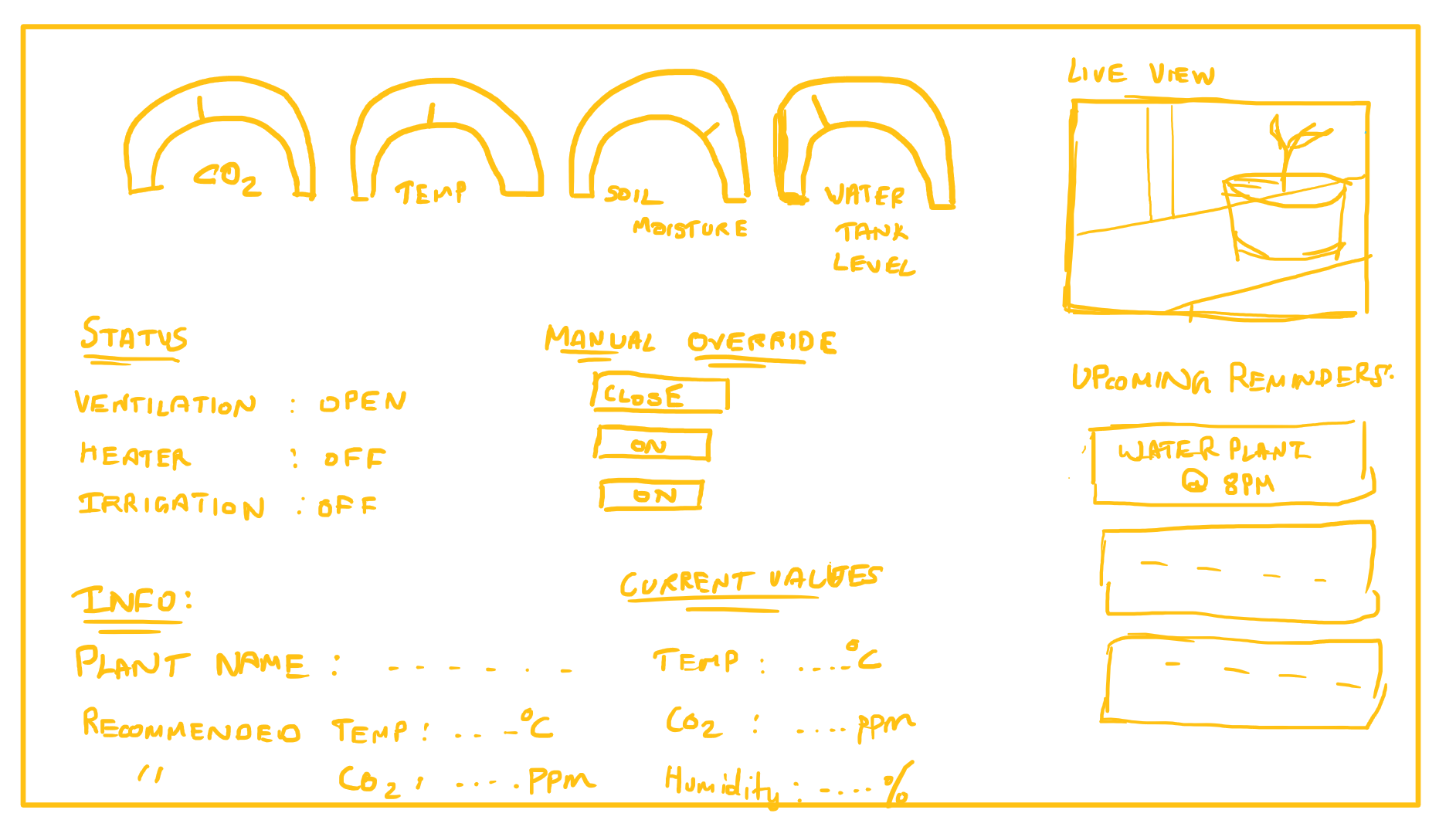
The above images show the initial brainstorming and ideation of the greenhouse prototype and the website design. Considering that the greenhouse is designed for use in balconies where space may be limited, we realised that a shape that resembles a glass cabinet or cupboard could suit our requirements sufficiently. The figure above (left) shows a potential design with sprinklers on the ceiling and an automated ventilation system on the side, along with the sensors, microcontroller and pump housed at the bottom base of the system. This ensures a low centre of gravity because most of the weight is concentrated in the bottom half of the housing, ensuring stability. The website design (top right) shows live gauges of the various parameters to be controlled within the greenhouse, such as CO2 levels, temperature and the soil moisture of the plants. It also shows the status of the various automated systems such as the automatic ventilation (window), the heater and the drip irrigation system. The website will also have a manual override system that allows users to override the automation system when they feel more comfortable managing their crops themselves, or when they suspect the system is not behaving optimally. The website will allow users to select the desired plant from a database, which then recommends the users of the optimal parameters for the selected plant (temperature, soil moisture, etc.).
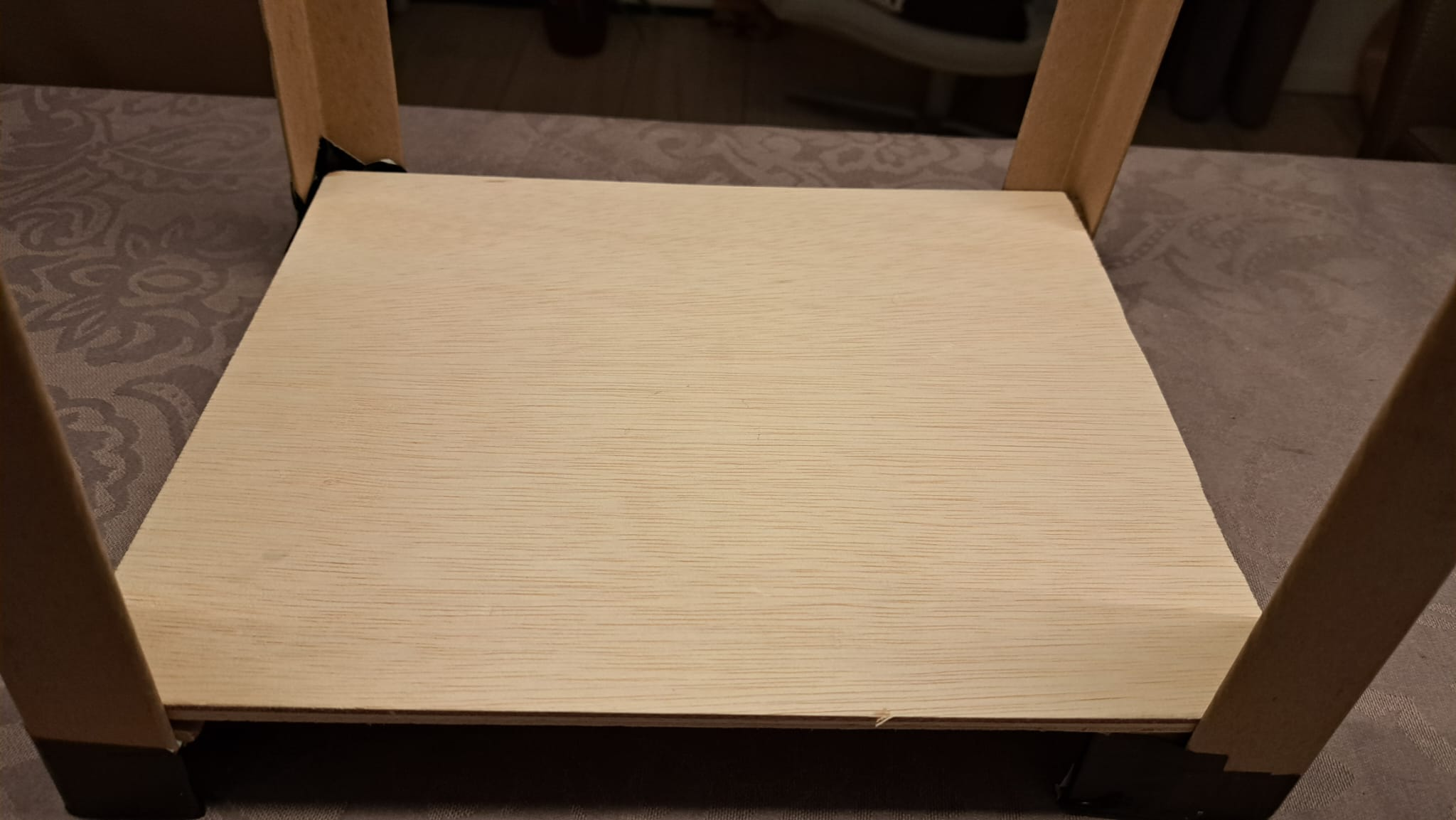
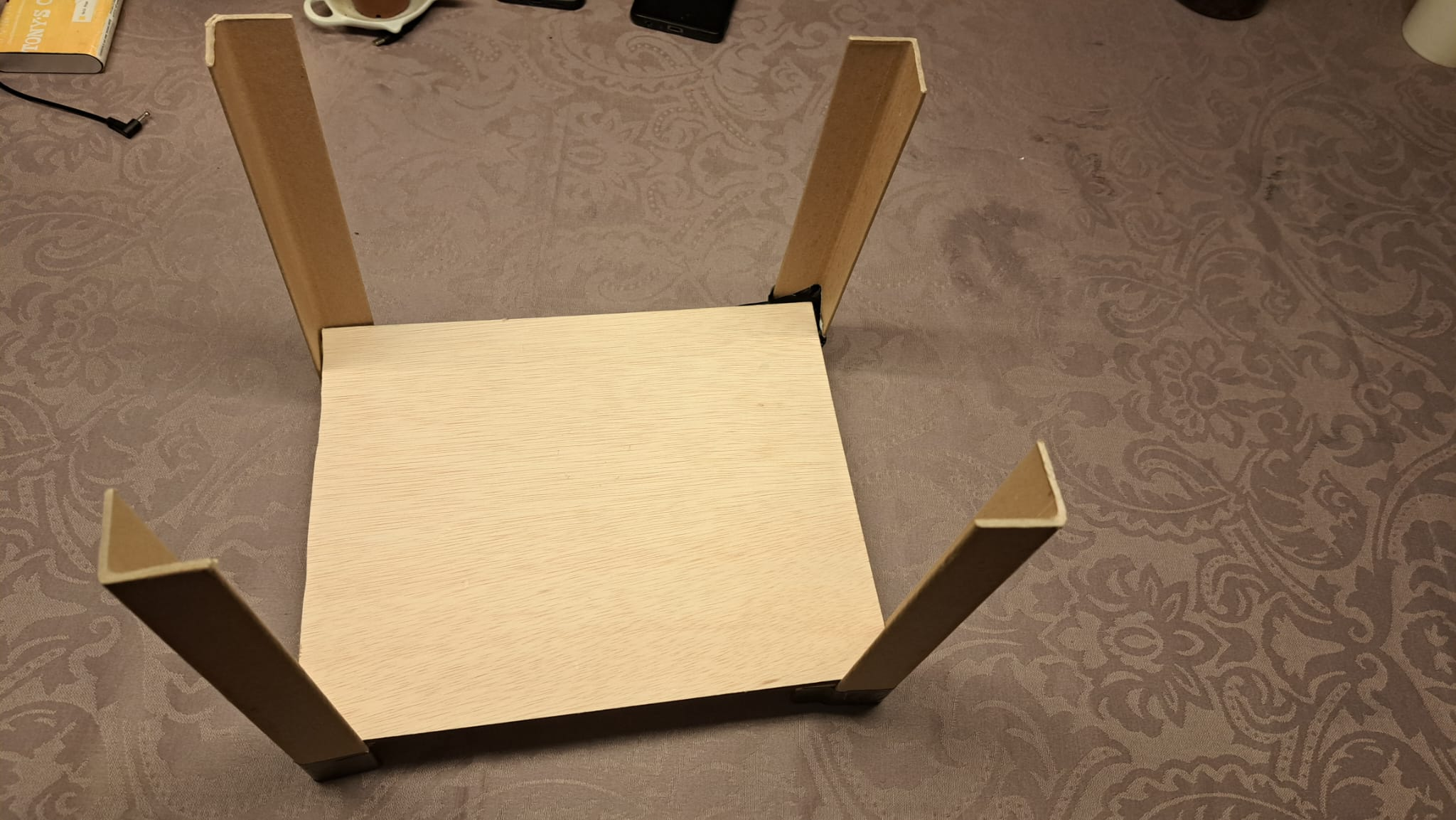
The figures above show the basic wooden structure of the greenhouse. It will later be fitted with windows on all four sides and a transparent ceiling to allow for sunlight and heat. The wooden base is where the plants will be placed by the user. The microcontroller and the breadboard, as mentioned previously, will be attached below the base to allow for stability of the frame.
The figures below reveal the final prototype:
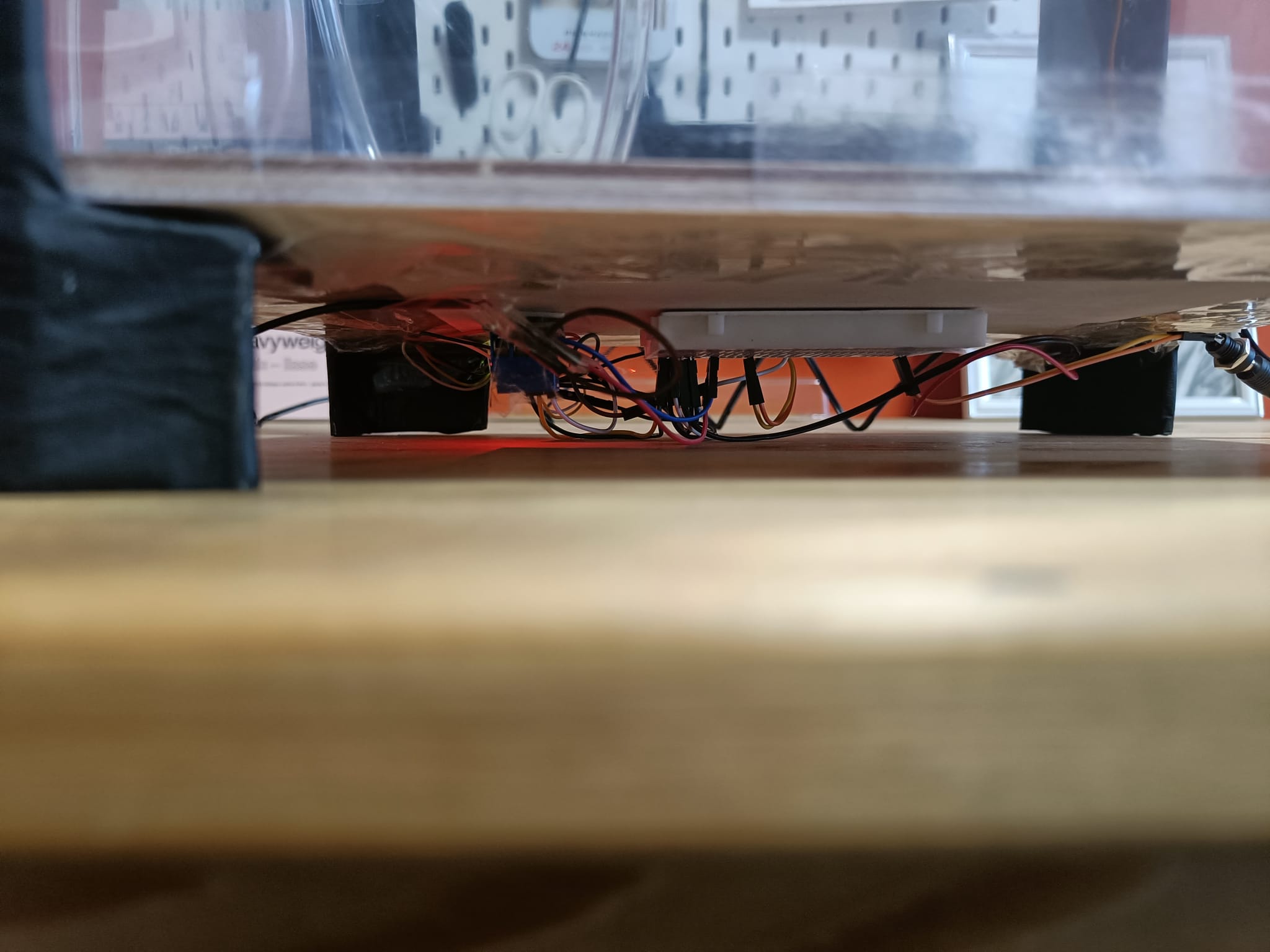
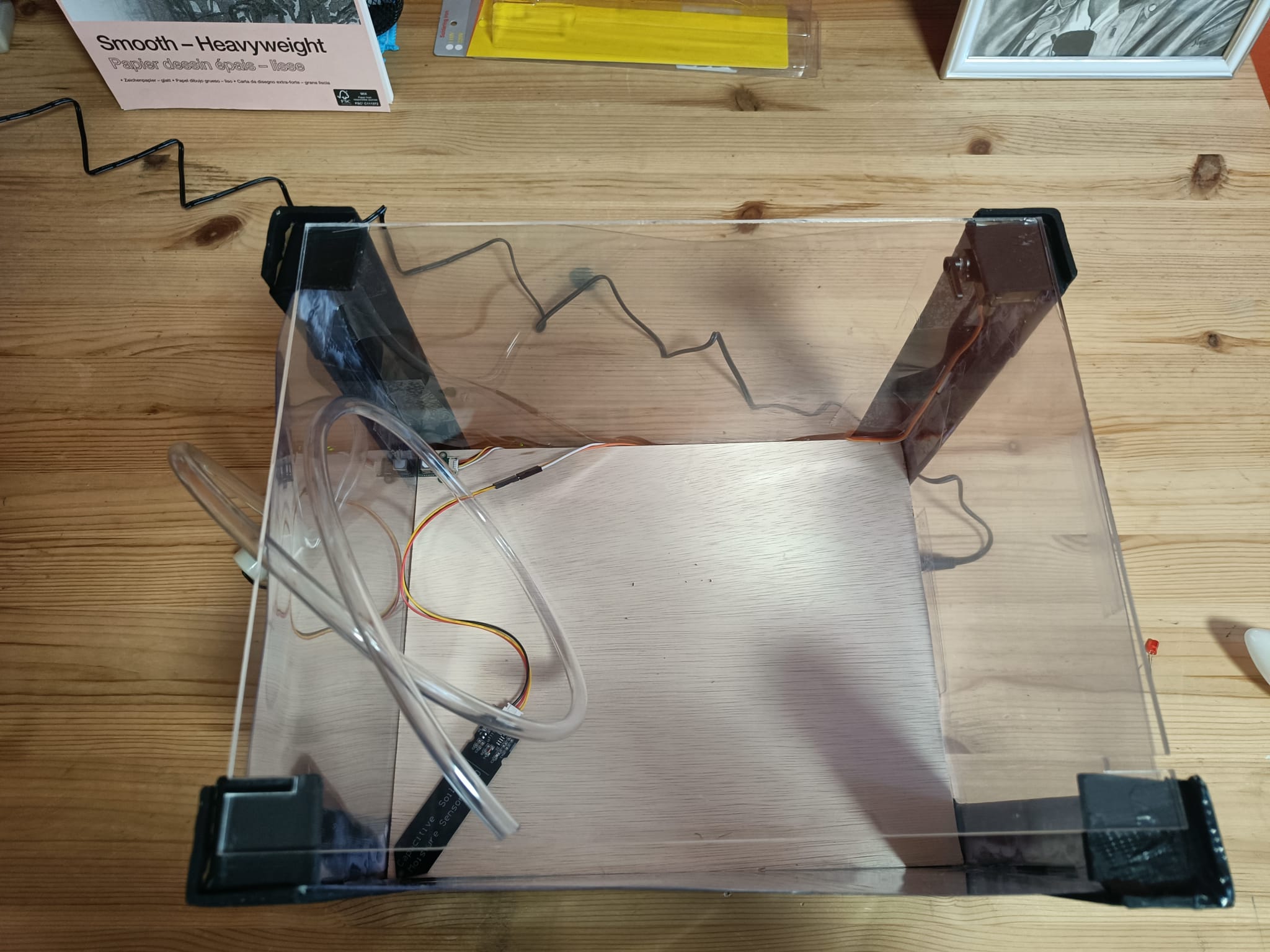
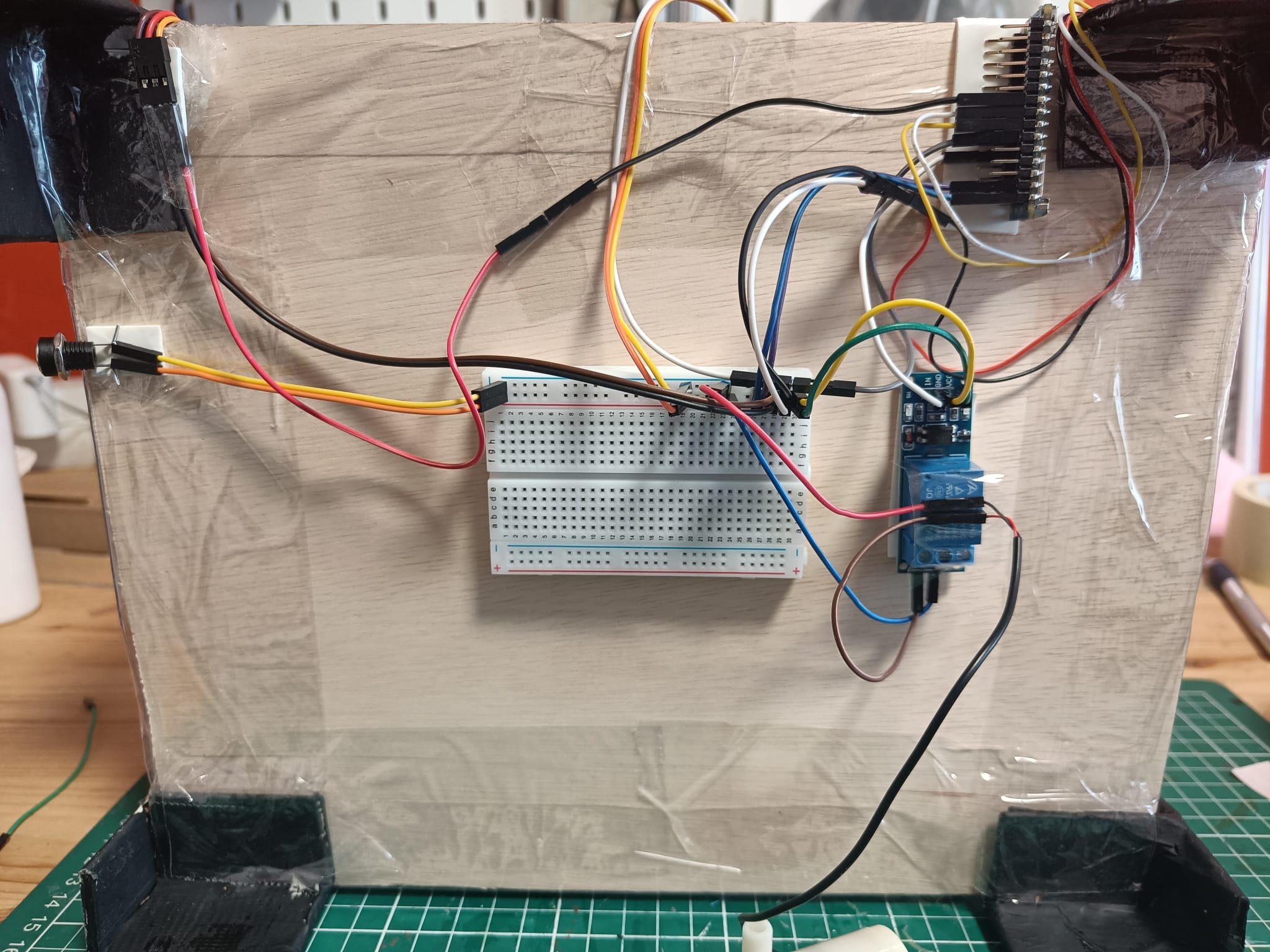
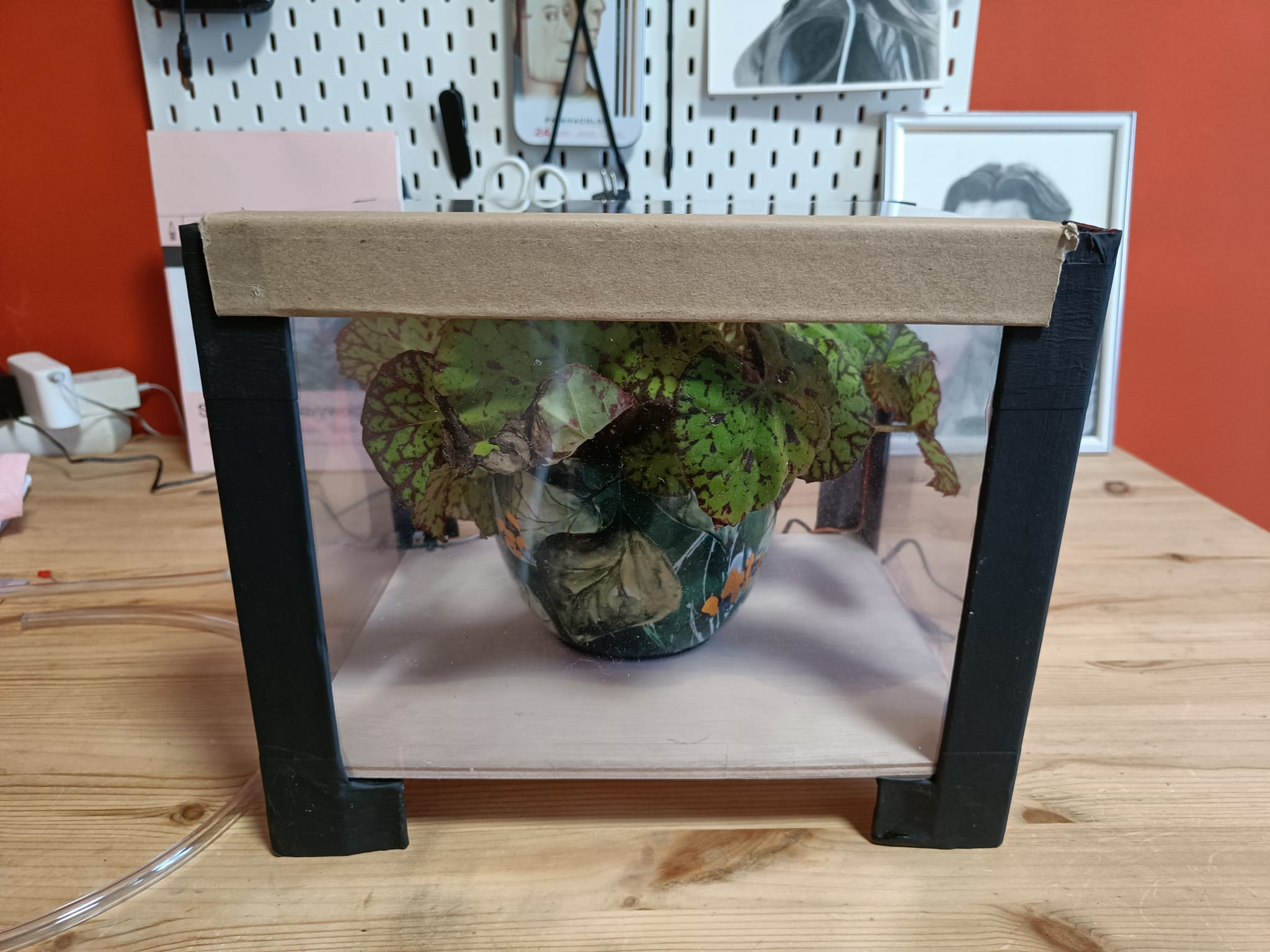
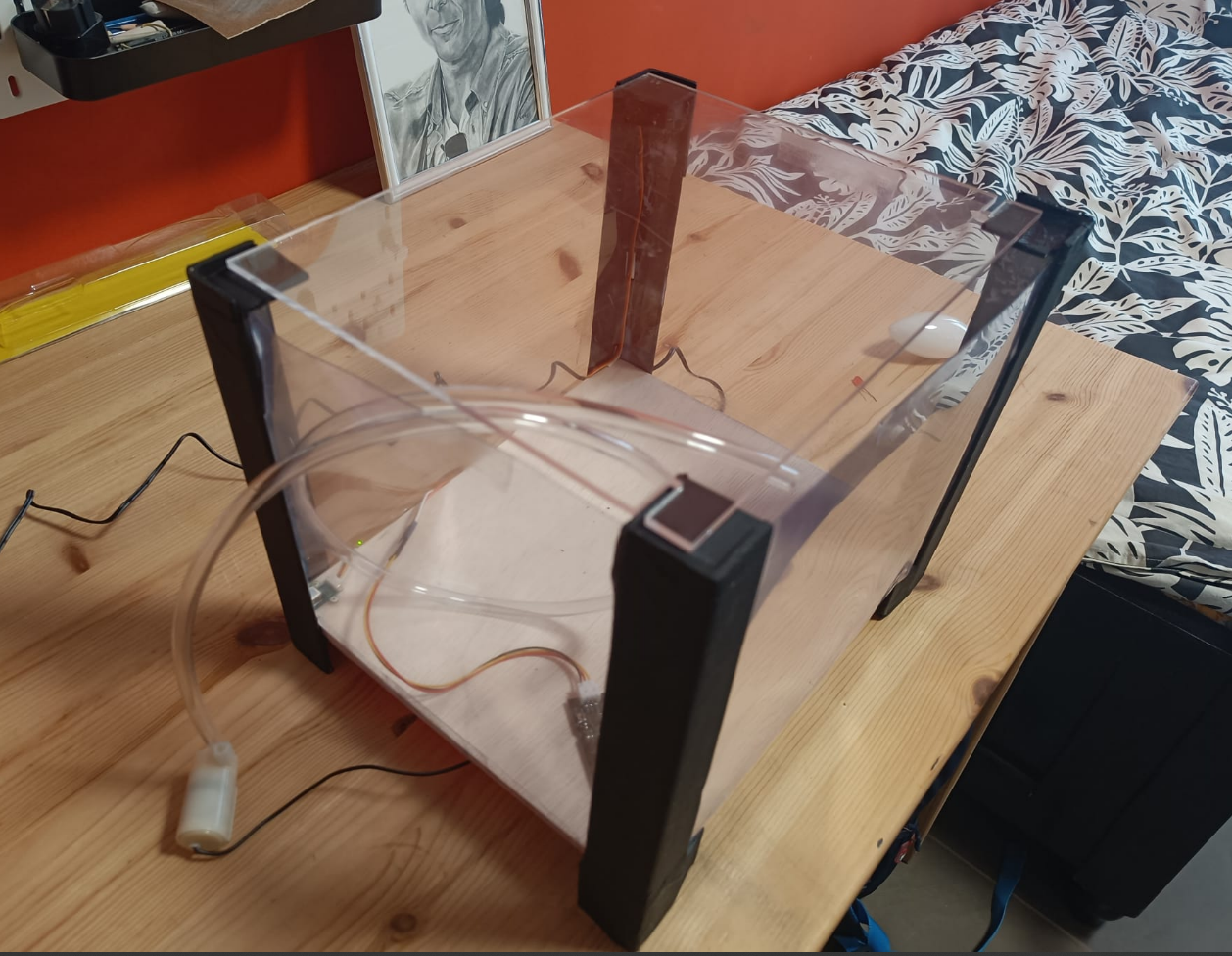
The figures above show the final prototype from different perspectives. As discussed earlier, the microcontroller and breadboard are placed underneath the base of the greenhouse to allow for stability and structural integrity, while also ensuring an aesthetically pleasing final design where the cables are not clearly visible. The breadboard connects the Arduino to all the sensors and actuators of the greenhouse. The sensors, including the CO2, temperature, humidity and soil moisture sensors, are located towards the bottom base of the frame (as seen in the diagonal view). The soil moisture sensor is to be placed relatively deep inside the plant. The servo motor actuator controlling the openable ceiling is activated when either the CO2 is too low or when the temperature is too high, depending on an algorithm designed to optimise plant growth.
Final Website:
These threshold values depend on the target plant, which can be selected by the user using the "Automated Greenhouse" website: Automated Greenhouse Dashboard. Images of the website are shown below:

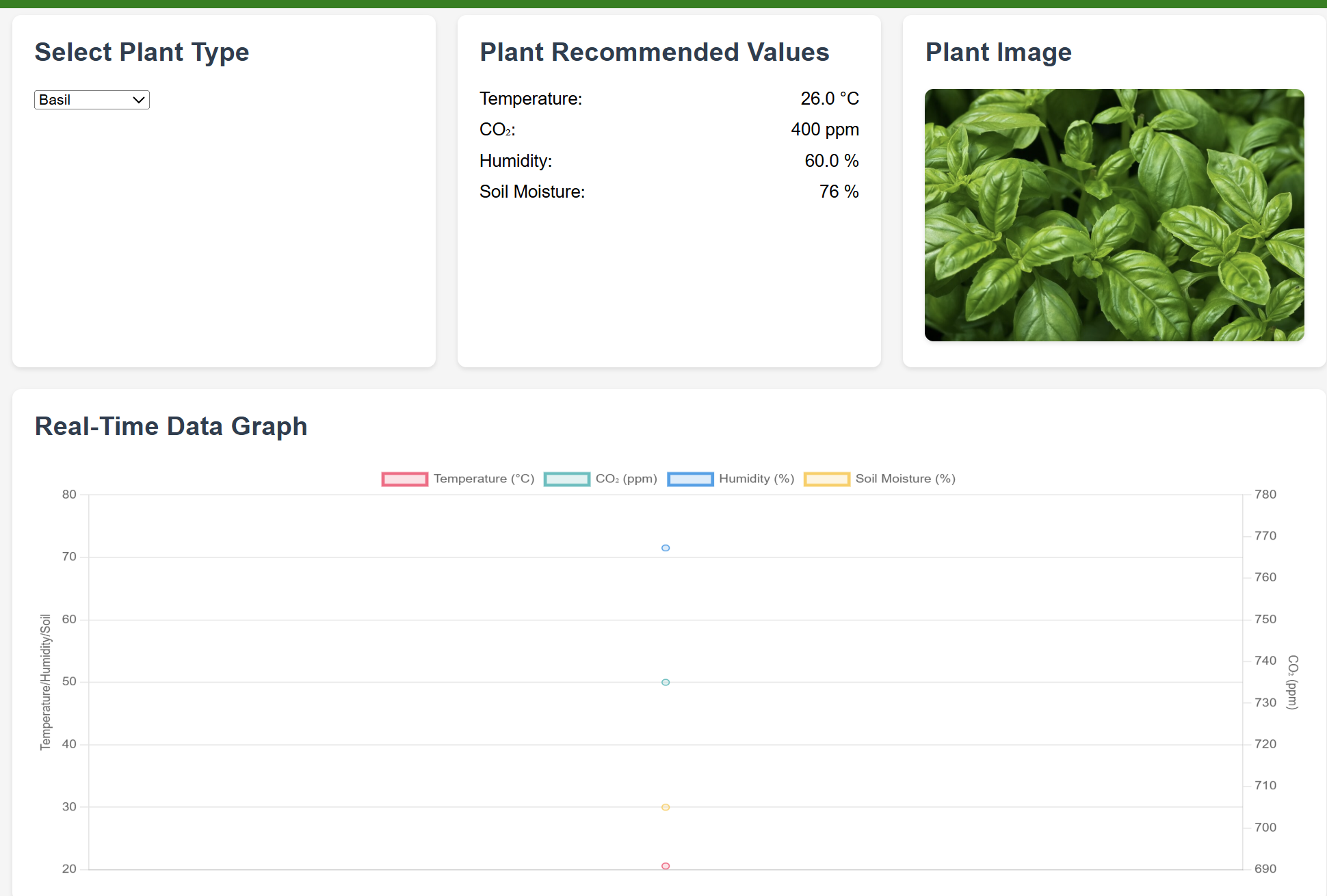
The screenshots reveal the design of the final user website. The top image shows...
The bottom image shows... [TO BE ADDED!!!]
